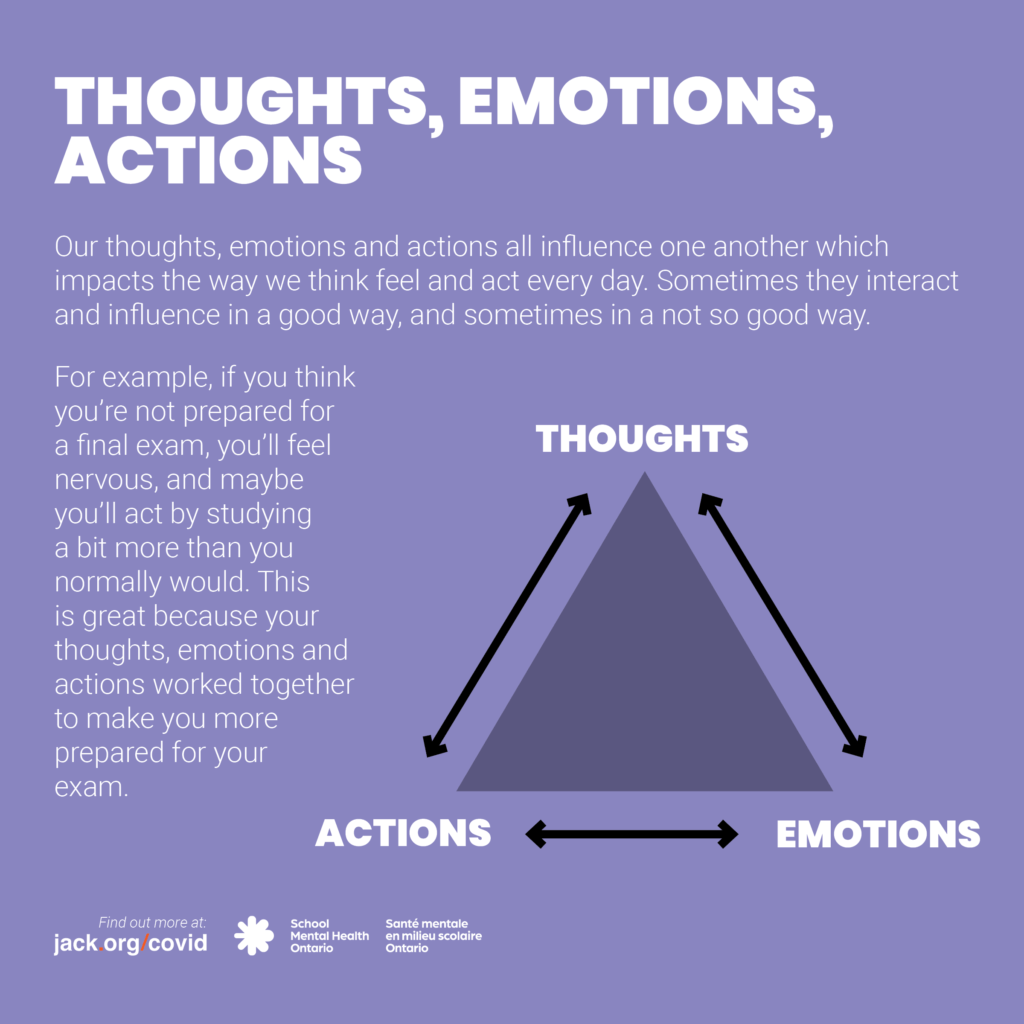


Time
10 minutes to introduce; 15-20 minutes for the activity
Level
Intermediate
Material
Blank “TEA Triangle” worksheets, scenarios
Purpose
To reinforce that thoughts, feelings, and actions are interrelated and that breaking the negative thinking cycle can help students feel happier and healthier
The idea of thoughts and actions influencing our emotions is true for marginalized and racialized students as well. However, there may be negative assumptions/biases about the Black community and other marginalized communities that may inform and invade a student’s thoughts about themselves. This must be challenged and explicitly addressed to overcome a negative sense of self.
Furthermore, it is important to recognize when students are marginalized, they may experience micro-aggressions; therefore, it is important to validate their experience, rather than saying that they should change their thoughts about the situation.
Explain the realistic-thinking concept (See “Evidence” section).
- Give an example that illustrates how easy it is to misinterpret the emotions and behaviours of others. Emphasize that when we make negative assumptions, it can make us think negative thoughts, and feel negative emotions.
- Draw a triangle (write Thoughts, Emotions, Actions at each angle) and highlight how common negative thoughts can lead to negative feelings and actions.
- Ask students to brainstorm alternative thoughts that are more realistic/helpful and discuss how these impact their emotions and actions.
- Give students a chance to work in pairs or small groups to complete their triangle.
- Students can generate and record problem situations on cards.

Thoughts, Emotions, Actions
The image contains a triangle diagram. “Thoughts”, “emotions”, and “actions” are each written at one corner of the triangle. Double ended arrows run along the sides of the triangle, connecting the words at each corner.
The text on the image reads:
Our thoughts influence our emotions, our emotions influence our actions and our actions influence our thoughts. Sometimes, our thoughts influence our emotions and actions in a good way.
For example, if you think you’re not prepared for a final exam, you’ll feel nervous, and maybe you’ll act by studying a bit more than you normally would. This is great because your thoughts, emotions and actions worked together to make you more prepared for your exam.
- This practice can be done regularly when students can write down/discuss their ideas on a topic.
- Scenario ideas: your friend played with someone else today, educator did not call on you when you had your hand raised, did not do well on a test, was not selected for the school play.
Thoughts and emotions are bi-directionally influential, which means that emotions influence students’ thoughts about a situation, and their thoughts influence their emotional reaction to a situation (Clore & Palmer, 2009; Oatley & Johnson-Laird, 2014). Understanding this phenomenon is the first step in developing the skills to manage this cycle, by changing the way students think about situations (Webb, Miles, & Sheeran, 2012).
Clore, G.L., & Palmer,J. (2009). Affective guidance of intelligent agents: How emotion controls cognition. Cognitive Systems Research, 10(1), 21-30. doi:10.1016/j.cogsys.2008.03.002
Oatley, K., & Johnson-Laird, P. N. (2014). Cognitive approaches to emotions. Trends in Cognitive Sciences. doi:10.1016/j.tics.2013.12.004
Webb, T. L., Miles, E., & Sheeran, P. (2012). Dealing with feeling: A meta-analysis of the effectiveness of strategies derived from the process model of emotion regulation. Psychological Bulletin, 138(4), 775-808. doi:http://dx.doi.org/10.1037/a0027600
Or, view all practices and use filters to find what you need
